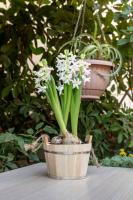How Far to Plant Dwarf Fruit Trees Apart
Dwarf fruit trees are a popular choice for gardeners, homeowners and even commercial orchardists who want to grow fruit, but have limited space. These trees are smaller in size compared to traditional fruit trees and are easier to manage, harvest and maintain. One important factor to consider when planting dwarf fruit trees is the distance between the trees. Proper spacing is crucial to keep your trees healthy and productive, as well as to optimize the yield of your fruit. So, how far do you need to plant dwarf fruit trees apart? Let’s find out.
The Basics of Spacing Dwarf Fruit Trees
When planting dwarf fruit trees, the general rule of thumb is to space them at a distance of 6 to 10 feet apart. The exact distance will depend on the growth habit of the tree, the rootstock used, the soil conditions and the climate of your location. For example, dwarf apple trees on semi-dwarfing rootstocks may need to be spaced closer together than peach trees on a vigorous rootstock.
Spacing your trees too close may lead to overcrowding, competition for resources, increased disease pressure, lower air circulation, and lower fruit yields. On the other hand, spacing them too far apart may waste valuable growing space, make pruning and harvesting more difficult, and create gaps in your orchard that may need to be filled later.
Factors That Affect Spacing
Before you plant your dwarf fruit trees, make sure to consider the following factors that may affect their spacing:
Growth habit: Some dwarf fruit trees, such as peach and nectarine, tend to have a more spreading habit, while others, such as apple and pear, tend to be more upright. The spacing will depend on the width and height of the tree when mature.
Rootstock: Dwarf fruit trees are usually grafted onto specific rootstocks that control their size and vigor. The spacing will depend on the rootstock used and the eventual size of the tree.
Soil conditions: The spacing may need to be adjusted if the soil is poor in nutrients, water or drainage, as this may affect the growth rate and canopy size of the tree.
Climate: In warmer climates, trees may need more space to allow for air circulation and to reduce disease pressure. In colder climates, trees may be spaced closer together to create a windbreak effect and to maximize the use of the available growing space.
Tips for Spacing Dwarf Fruit Trees
Here are some tips to help you space your dwarf fruit trees properly:
Measure the space: Use a measuring tape, a yardstick or a rope to mark the planting spots and measure the distances between them.
Consider the row spacing: If you are planting in rows, make sure to space the rows at a distance that allows easy access for pruning, spraying and harvesting. A distance of 12 to 15 feet is usually recommended between rows.
Follow the label instructions: If you purchase your dwarf fruit trees from a nursery, make sure to follow the label instructions for spacing and planting depth.
Plan for future growth: Remember that your trees will grow and develop over time. Make sure to space them with enough room for their eventual size and canopy spread.
Ask for expert advice: If you are unsure about the proper spacing for your dwarf fruit trees, don’t hesitate to ask a local extension agent, a master gardener or a horticulturist for advice.
The Bottom Line
Spacing your dwarf fruit trees properly is an important aspect of their care and maintenance. By giving them enough room to grow and thrive, you ensure that they will produce healthy and abundant fruit for years to come. Take into account the various factors that may affect their spacing, and follow the tips and guidelines provided by experts in the field. Happy planting!

 how many times do yo...
how many times do yo... how many planted tre...
how many planted tre... how many pine trees ...
how many pine trees ... how many pecan trees...
how many pecan trees... how many plants comp...
how many plants comp... how many plants can ...
how many plants can ... how many plants and ...
how many plants and ... how many pepper plan...
how many pepper plan...






























